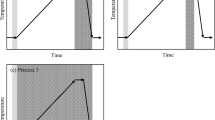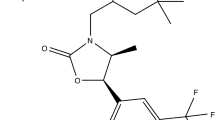Abstract
Amorphous solid of tri-O-methyl-β-cyclodextrin was formed by grinding the crystalline sample with a vibrating mill at room temperature. The amorphising process was examined by X-ray powder diffraction technique and differential scanning calorimetry (DSC). The Bragg peaks disappeared and the enthalpy of crystallization became constant for the sample ground for 25 min, indicating the apparent completion of the amorphization. A glass transition of the ground amorphous solid was found by DSC. The glass transition temperature Tg moved from 58°C to 79°C with grinding. The saturated Tg of the ground sample was the same as that of the liquid-quenched glass. No significant difference between the ground and liquid-quenched amorphous solids was found in the X-ray diffraction patterns. Infrared spectra of both amorphous solids, however, showed a definite difference for the band at 1194 cm−1 assigned to the rocking of the CH3 groups which are located at the molecular periphery.
Zusammenfassung
Amorphes festes Tri-O-methyl-β-cyclodextrin wurde bei Raumtemperatur durch Mahlen einer kristallinen Probe in einer Vibrationsmühle hergestellt. Der Amorphisierungsprozeß wurde mittels Röntgenpulverdiffraktion und DSC verfolgt. Die Braggschen Peaks verschwanden und die Kristallisierungsenthalpie nahm nach einem Mahldauer von 25 min einen konstanten Wert an, was auf die augenscheinliche Beendigung des Amorphisierungsprozesses hinweist. Mittels DSC wurde ein Glasumwandlungspunkt des gemahlenen amorphen Feststoffes gefunden. Die Glasumwandlungstemperatur Tg stieg durch das Mahlen von 58°C auf 79°C. Der Sättigungswert Tg der gemahlenen Probe war der gleiche wie für flüssigkeitsabgeschrecktes Glas. In den Röntgendiffraktogrammen konnte zwischen den gemahlenen und den flüssigkeitsabgeschreckten amorphen Feststoffen keinen Unterschied feststellen. Die IR-Spektren von beiden amorphen Feststoffen zeigen einen signifikanten Unterschied für die Bande bei 1194 cm−1, der Nickschwingung der CH3-Gruppen am Molekülrand.
Similar content being viewed by others
References
S. R. Elliott, “Physics of Amorphous Materials”, Longman, London 1984.
R. Zallen, “The Physics of Amorphous Solids”, John Wiley & Sons, New York 1982.
W. Vogel, “Chemistry of Glass”, The American Ceramic Society, Inc., Columbus 1985.
“Solid State Amorphizing Transformations”, eds. R. B. Schwarz and W. L. Johnson, J. Less-Common Met., 140 (1988).
E. Hellstern, L. Schultz and J. Eckert, J. Less-Common Met., 140 (1988) 93.
R. B. Schwarz and C. C. Koch, Appl. Phys. Lett., 49 (1986) 146.
A. Ye. Yermakov, Ye. Ye. Yurchikov and V. A. Barinov, Fiz. Met. Metalloved., 52 (1981) 1184; 54 (1982) 935.
K. Suzuki, J. Non-Cryst. Solids, 112 (1989) 23.
“Relaxation in Complex Systems”, eds. K. L. Ngai and G. W. Wright, Office of Naval Research, Washington, D. C., 1984.
“Dynamic Aspects of Structural Change in Liquids and Glasses”, eds. C. A. Angell and M. Goldstein, Ann. N. Y. Acad. Sci., 484 (1986).
H. Hikawa, M. Oguni and H. Suga, J. Non-Cryst. Solids, 101 (1988) 90.
M. Oguni, H. Hikawa and H. Suga, Thermochim. Acta, 158 (1990) 143.
K. Takeda, M. Oguni, O. Yamamuro and H. Suga, to be published.
S. Takahara, O. Yamamuro and H. Suga, to be published.
K. Takeda, O. Yamamuro and H. Suga, J. Phys. Chem. Solids, 52 (1991) 607.
K. Kawano and Y. Nakai, Yakugaku Zasshi, 105 (1985) 1071.
Y. Nakai, K. Yamamoto and K. Terada, J. Incl. Phenom., 2 (1984) 523.
G. A. El-Gendy, K. Terada, K. Yamamoto and Y. Nakai, Int. J. Pharm., 31 (1986) 25.
B. Casu, M. Reggiani, G. G. Gallo and A. Vigevani, Tetrahedron, 24 (1968) 803.
G. Adam and J. H. Gibbs, J. Chem. Phys., 43 (1965) 139.
R. B. Schwarz, Mat. Sci. Eng., 97 (1988) 71.
Author information
Authors and Affiliations
Additional information
Dedicated to Professor Dr. H. J. Seifert on the occasion of his 60th birthday
Contribution No. 35 from the Microcalorimetry Research Centre.
The authors thank the research group of Professor Yoshinobu Nakai, Faculty of Pharmaceutical Science, Chiba University, for their kind advice for the grinding-amorphization method. The authors are deeply indebted to Mr. Tetsuo Yamamoto for his X-ray diffraction experiments and Mr. Shin-ichi Ishikawa for his IR experiments.
Rights and permissions
About this article
Cite this article
Tsukushi, I., Yamamuro, O. & Suga, H. Solid state amorphization and glass transition of tri-O-methyl-β-cyclodextrin. Journal of Thermal Analysis 37, 1359–1371 (1991). https://doi.org/10.1007/BF01913474
Received:
Issue Date:
DOI: https://doi.org/10.1007/BF01913474




